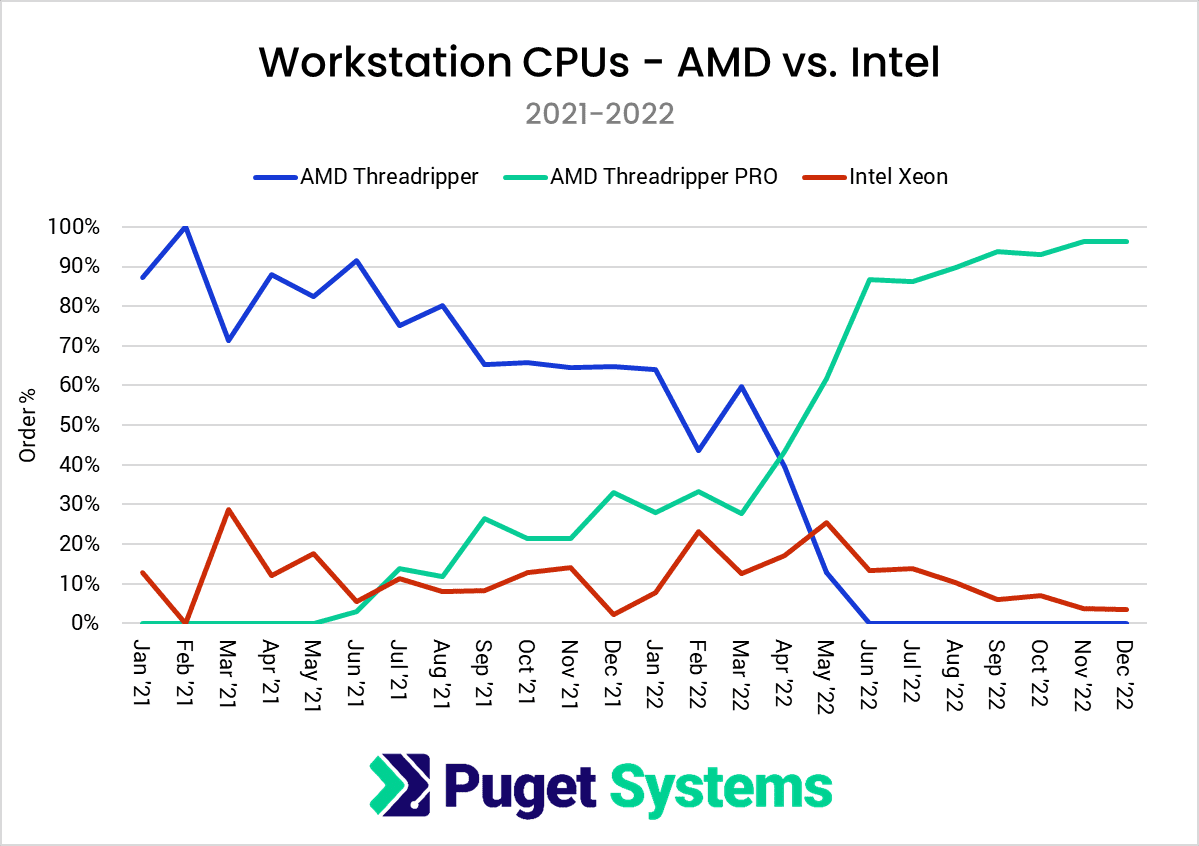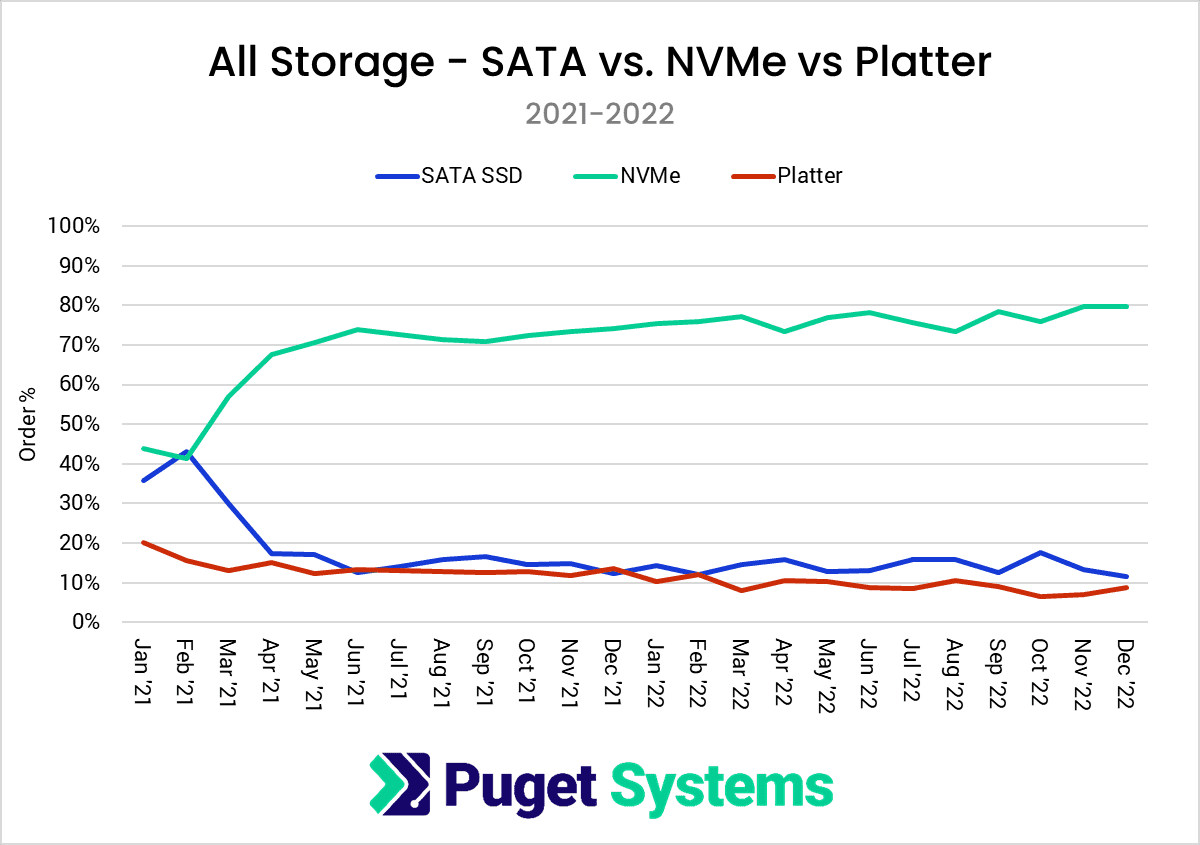Intel Prevails In Client CPU Sales, But Threadripper Pro Outsold Xeon Nearly 20:1 : Report
Custom PC builder Puget Systems has shared its hardware trends of 2022, a detailed report that reveals the company's sales for processors, graphics cards, storage, and other tidbits. However, it's important to emphasize that the data refers to Puget Systems' sales; therefore, it doesn't represent global sales or market share.
AMD had a great 2021 year, finishing with over 70% market share in client processor sales. The chipmaker had a formidable line-up of Zen 3 chips at the time, and Intel's 11th Generation Rocket Lake processors couldn't compete. However, Intel slowly recovered its market share with the 12th Generation Alder Lake processors, the company's first desktop hybrid parts. The data from January 2022 to December 2022 shows a steady decline in AMD Ryzen usage. AMD eventually unleashed its Ryzen 4 processors in September of 2022, and Intel was quick to fire back with its 13th Generation Raptor Lake chips. Nevertheless, Puget System noted that Zen 4 and Raptor Lake ended up in a deadlock and didn't influence the state of the market share. The scales had already flipped, and Intel finished 2022 with a market share that surpassed 70%.
Intel clearly wasn't a match for AMD in the workstation segment. By the end of 2022, Threadripper Pro processors owned 95% of the market share, whereas the remaining 5% went to Xeon chips. AMD's Threadripper processors had outsold Intel's offerings by nearly 20:1. Threadripper has gained favor with Puget System due to the processor's irresistible attributes, such as more cores, a richer feature set, and a more affordable price tag over rival Xeon chips.
With the Ryzen Threadripper Pro 5000 WX-series processors, AMD stopped offering the regular variants to the retail market, marking the end of HEDT processors. Like other system integrators, Puget Systems had no choice but to transition to the more expensive Pro versions. The Threadripper Pro 5000 WX series hit the market in Q3 2022, the time frame when the chips started to catapult to the top of the Puget Systems charts.


Puget Systems tailors its workstations towards specialized workloads, including content creation, engineering, and scientific computing. The company, which solely utilizes Nvidia's products, discovered an increasing trend for professional graphics (Nvidia RTX, formerly Quadro) cards. For instance, Nvidia's GeForce graphics cards represented over 90% of the company's sales. However, Puget System ended 2022 with just 80%.
The demand for professional graphics cards isn't growing exponentially. However, Puget System believes that there are two main reasons for pushing customers toward professional graphics cards. The first reason is that Nvidia's GeForce graphics card has become poor choices for multi-GPU configurations. The second reason is that the increasing popularity of virtual production and AI has prompted consumers to turn to professional graphics cards.
It's not a coincidence that Nvidia's mainstream Geforce graphics cards have stopped being compelling options for multi-GPU systems. This is because Nvidia has limited NVLink support over the previous generations of GeForce graphics cards. For instance, the Geforce RTX 3090 (Ampere) was the last mainstream GeForce product to feature NVLink support until Nvidia completely pulled the plug on NVLink on the latest GeForce RTX 40-series (Ada Lovelace) graphics cards.
Get Tom's Hardware's best news and in-depth reviews, straight to your inbox.
There's also a lack of blower-type GeForce models, which are the kinds that you want in a server rack with numerous graphics cards sandwiched together. Almost every Nvidia partner had a blower version of the GeForce RTX 3090, then miraculously disappeared or was made end-of-life. There were whispers that Nvidia wasn't too happy that some system integrators were using these GeForce RTX 3090 blower graphics cards instead of their products more expensive professional offerings. GeForce RTX 4090 blower models are on the market if you look hard enough. But it's rare, and even the vendor fears putting its name on it. In addition, the lack of an NVLink connector doesn't make the GeForce RTX 4090 an attractive option.
Due to the almost parity between NVMe and SATA SSDs at the lower capacities, it's unsurprising that the former is the primary storage device in 95% of Puget Systems' products. In addition, further pricing improvements have brought 1TB or less NVMe drives within a few dollars range of a conventional SATA SSD. As a result, Puget System's usage of NVMe SSDs as the primary device has grown to 100%.
Although NVMe SSDs are within consumer buying capacity, SATA SSDs and hard drives are still somewhat relevant for secondary storage. Regarding overall drive usage, NVMe drives represent an 80% market share. However, SATA SSDs and hard drives still occupy 10% of the storage usage. Puget System assessed that until high-capacity NVMe drives, such as those 4TB and larger, drop in pricing, it doesn't expect SATA SSDs, and much less hard drives, to go away anytime soon.



Puget Systems was reluctant to transition entirely to Windows 11 at its debut. There were concerns about application compatibility and performance deterioration. As a result, the adoption rate was slow until around July 2022, when it started to ramp up. Nonetheless, Puget Systems' preference for Windows 11 didn't pass Windows 10 until October 2022. The company still has customers that prefer Windows 10; however, it won't be long. As of March 2023, 70% of the systems that Puget Systems sell has Windows 11 as the operating system.
At the time, Zen 4 and Raptor Lake weren't on the market long enough to be a factor in the charts. With more time to fight it out, AMD may snatch more markets from Intel. As for the workstation segment, Intel recently launched the company's 4th Generation Sapphire Rapids Xeon chips, pushing the core count up to 60 to rival AMD's Threadripper. However, AMD won't just stand still with its arms crossed. The chipmaker's Threadripper 7000 (Storm Peak) chips with Zen 4 cores will hit the market before the year ends. So it'll be interesting to see whether Sapphire Rapids will help Intel gain some ground in the workstation segment.
Puget Systems is convinced that Nvidia is the way to go regarding graphics card options. Unless AMD launches something convincing this year, it's hard to imagine an AMD graphics card on Puget Systems' chart next year.

Zhiye Liu is a news editor, memory reviewer, and SSD tester at Tom’s Hardware. Although he loves everything that’s hardware, he has a soft spot for CPUs, GPUs, and RAM.
-
Not surprised at all. All of our systems from Puget are thread ripper’s. They are the nicest AND FASTEST machines I have ever used.Reply
no gaming nonsense just pure software development and building -
hotaru251 not shocking.Reply
AM5 has been costly to adopt vs intel's. 13th gen.
and again not shocking...AMD just murders intel on workstation stuff. -
bit_user ReplyGeForce RTX 4090 blower models are on the market if you look hard enough. But it's rare, and even the vendor fears putting its name on it.
Reminds me of how Nvidia workstation cards are also mysteriously the only ones that have the supplemental power connector on the end, which allows them to fit a 3U case.
As for that GPU, the normal way to figure out whose card it is would be to look at the FCC ID, silk screened on the PCB. That model was reportedly bought in Japan, and therefore might not have undergone FCC testing, but they must do something similar.
However, it could turn out that some independent company bought already-made RTX 4090's and then simply swapped the axial fan cooler with a blower type and resold them. In that case, the original manufacturer might not have any knowledge of who's doing it.
On a related note, I've seen on ebay where some sellers are offering aftermarket BIOS chips. I believe these can be used to trick a consumer card into thinking it's a workstation model, at least for the Radeon VII that I saw them for. In Nvidia's case, it could do things like unlocking some limiter on the tensor cores, if such hacks exist for them. -
bit_user Reply
Not relevant, when we're talking about customers of a boutique builder like Puget.hotaru251 said:not shocking.
AM5 has been costly to adopt vs intel's. 13th gen.
Just to test it out, I configured a mini-tower with a 7950X and the price came out to $3502.63. I then configured a mini-tower with a i9-13900K (same RAM and GPU) and it came out to $3585.43! Even if it had been the other way around, anyone spending a whopping $3.5k on a mainstream desktop-class machine with a mere 32 GB of RAM and a RTX 3060 Ti GPU won't flinch at a price difference of a mere $80 or so.
Same goes for GPUs, where the main argument for AMD GPUs is better perf/$. That's why Puget can afford to be Nvidia-exclusive - their customers aren't very price-sensitive. -
Jimbojan Puget sale does not represent the whole industry sale, Intel's data center business last quarter was $4.3B, while AMD was $1.2B in the same period, clearly your report is distorted at best, if it is not a scam.Reply -
Avro Arrow This is no surprise. Zen has been crushing Xeon like grapes in a winery ever since EPYC and Threadripper came out. The upcoming EPYCs are poised to virtually eradicate Intel from the data centre space and if a TR version is made of them, Intel will be essentially locked out of the HEDT space as well.Reply -
bit_user Reply
I'd suggest it really wasn't until Zen 2 that EPYC and Threadripper posed a serious threat to Intel.Avro Arrow said:Zen has been crushing Xeon like grapes in a winery ever since EPYC and Threadripper came out.
The main selling points of the Zen and Zen+ -derived EPYC and Threadripper were their price and PCIe lane-count. Their max of 32 cores wasn't far enough above Intel's 28-core Xeons to be very interesting. -
If you use them for business, they are worth every penny of that 3500 because we’ve replaced about 16 consumer cpu based machines with fourReply
and those new machines aren’t even breaking a sweat. -
bit_user Reply
You said you bought ThreadRipper models, though. The default config for their TR systems will cost you $8497.04 - that's with a 24-core CPU, 128 GB RAM (8x16), and a RTX 4080. If you just increase the CPU to the 64-core model, the price jumps to $12,932.98 !!Mandark said:If you use them for business, they are worth every penny of that 3500 because we’ve replaced about 16 consumer cpu based machines with four
For a business, it's defensible to spend that kind of money. Even with an aggressive upgrade cycle of 3 years, it's peanuts compared to a professional salary over that time. But businesses also tend to be cheap and look to save money where they can. So, I think most would go with a bigger OEM like Dell or HP, and probably try to do with lower-spec machines, too.
Back in the day, workstations used to cost real money. I remember when an EDA consultant was brought in at a previous job I worked, and they set him up with an UltraSparc workstation that cost like $90k.
